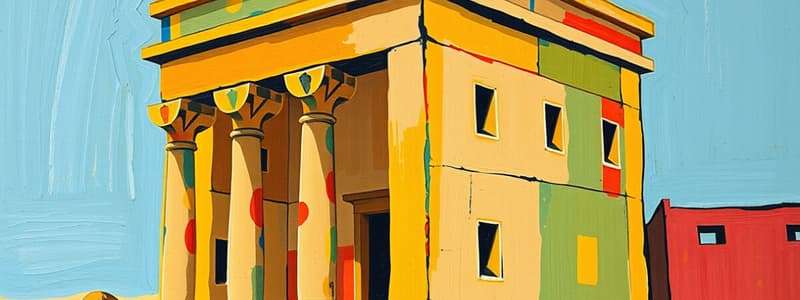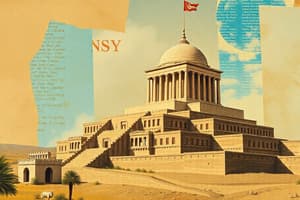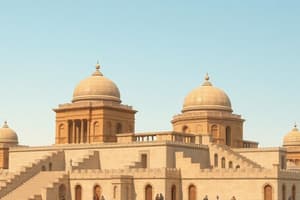Podcast
Questions and Answers
Which architectural material is commonly used in West Asiatic architecture?
Which architectural material is commonly used in West Asiatic architecture?
- Timber and colored limestones (correct)
- Wood
- Concrete
- Steel
The Mesopotamian civilization is located near the Nile River.
The Mesopotamian civilization is located near the Nile River.
False (B)
What is the Greek term for 'in between rivers' and which two rivers does it refer to?
What is the Greek term for 'in between rivers' and which two rivers does it refer to?
Meso and Potamos; Tigris and Euphrates
In order to prevent flooding, important structures in Mesopotamia, such as the __________, were built on platforms.
In order to prevent flooding, important structures in Mesopotamia, such as the __________, were built on platforms.
Match the following civilizations with their respective locations:
Match the following civilizations with their respective locations:
What type of material did Assyria and Babylon primarily use for building?
What type of material did Assyria and Babylon primarily use for building?
Persian architecture frequently incorporates the use of monsters for decoration.
Persian architecture frequently incorporates the use of monsters for decoration.
What natural resource is used to make sun-dried bricks?
What natural resource is used to make sun-dried bricks?
In earlier courtyard architecture, a courtyard is an open space that is surrounded by other _____ spaces.
In earlier courtyard architecture, a courtyard is an open space that is surrounded by other _____ spaces.
Match the following regions with their respective characteristics or influence:
Match the following regions with their respective characteristics or influence:
What is a significant feature of Persian doorways?
What is a significant feature of Persian doorways?
Open courtyards were only used by the lower echelons of society.
Open courtyards were only used by the lower echelons of society.
Which civilization is one of the oldest known in the region currently known as Iran?
Which civilization is one of the oldest known in the region currently known as Iran?
What is a primary reason bricks were placed inside an oven or kiln?
What is a primary reason bricks were placed inside an oven or kiln?
Ziggurats were mainly used for residential purposes.
Ziggurats were mainly used for residential purposes.
Which color was difficult to obtain in ancient times and was reserved for royalty?
Which color was difficult to obtain in ancient times and was reserved for royalty?
The higher the structure, the more the god can see their ________.
The higher the structure, the more the god can see their ________.
Match the structure to its description:
Match the structure to its description:
Which of the following was NOT used as a pigment for colored glazed bricks?
Which of the following was NOT used as a pigment for colored glazed bricks?
Only priests and kings could access the top of a ziggurat.
Only priests and kings could access the top of a ziggurat.
What was the significance of the extra step in making kiln-dried bricks?
What was the significance of the extra step in making kiln-dried bricks?
What does the term 'esagila' refer to?
What does the term 'esagila' refer to?
The Palace of Sargon is located in Persepolis.
The Palace of Sargon is located in Persepolis.
Who was responsible for the construction of the Hall of Hundred Columns?
Who was responsible for the construction of the Hall of Hundred Columns?
The __________ is known as the grand or royal audience hall in the Palace of Persepolis.
The __________ is known as the grand or royal audience hall in the Palace of Persepolis.
Match the following structures with their descriptions:
Match the following structures with their descriptions:
Who completed the construction of the Palace of Persepolis?
Who completed the construction of the Palace of Persepolis?
The Assyrians and Babylonians primarily constructed palaces rather than temples.
The Assyrians and Babylonians primarily constructed palaces rather than temples.
Name the most important structure in Assyrian architecture.
Name the most important structure in Assyrian architecture.
The chief building in Assyria and Babylon is the __________.
The chief building in Assyria and Babylon is the __________.
What architectural feature is characteristic of Persian architecture?
What architectural feature is characteristic of Persian architecture?
King Ur Nammu was responsible for commissioning the great ziggurat located in Iraq.
King Ur Nammu was responsible for commissioning the great ziggurat located in Iraq.
What is the significance of the Hall of Hundred Columns?
What is the significance of the Hall of Hundred Columns?
The Hanging Gardens of Babylon were created by King __________ for his wife.
The Hanging Gardens of Babylon were created by King __________ for his wife.
What was a common ornamental feature in Assyrian and Babylonian architecture?
What was a common ornamental feature in Assyrian and Babylonian architecture?
Persian architecture incorporates ziggurats as an important element.
Persian architecture incorporates ziggurats as an important element.
What unique characteristic was noted about the roofs in Assyria and Babylon?
What unique characteristic was noted about the roofs in Assyria and Babylon?
The ziggurat of Ur is dedicated to which moon god?
The ziggurat of Ur is dedicated to which moon god?
The architecture of Persia is characterized by its __________ and airy magnificence.
The architecture of Persia is characterized by its __________ and airy magnificence.
Match the following kings with their contributions:
Match the following kings with their contributions:
Flashcards
West Asiatic Architecture
West Asiatic Architecture
Architecture in Persia using timber and colored limestones due to its distance from the Tigris and Euphrates rivers.
Mesopotamian Architecture
Mesopotamian Architecture
Architecture in the desert region of Persia, influenced by the Tigris and Euphrates rivers.
Elevated Structures
Elevated Structures
Structures built on elevated platforms to protect from flooding in regions like Assyria and Babylon.
Sumer
Sumer
Signup and view all the flashcards
Assyria
Assyria
Signup and view all the flashcards
Babylon
Babylon
Signup and view all the flashcards
Persia
Persia
Signup and view all the flashcards
Sun-Dried Bricks
Sun-Dried Bricks
Signup and view all the flashcards
Kiln-Dried Bricks
Kiln-Dried Bricks
Signup and view all the flashcards
Colored Glazed Bricks
Colored Glazed Bricks
Signup and view all the flashcards
Structural Integration
Structural Integration
Signup and view all the flashcards
Divine Kingship
Divine Kingship
Signup and view all the flashcards
Architectural Fusion
Architectural Fusion
Signup and view all the flashcards
King Ur Nammu
King Ur Nammu
Signup and view all the flashcards
King Nebuchadnezzar II
King Nebuchadnezzar II
Signup and view all the flashcards
Artaxerxes I
Artaxerxes I
Signup and view all the flashcards
Structural Differences
Structural Differences
Signup and view all the flashcards
Temple vs. Palace
Temple vs. Palace
Signup and view all the flashcards
Visual Motifs - Winged creatures
Visual Motifs - Winged creatures
Signup and view all the flashcards
Massive vs. Light Designs
Massive vs. Light Designs
Signup and view all the flashcards
Ziggurat of Ur
Ziggurat of Ur
Signup and view all the flashcards
Palace of Persepolis
Palace of Persepolis
Signup and view all the flashcards
Apadana
Apadana
Signup and view all the flashcards
Tatchara Palace
Tatchara Palace
Signup and view all the flashcards
Tripylon
Tripylon
Signup and view all the flashcards
The Treasury
The Treasury
Signup and view all the flashcards
Hall of Hundred Columns
Hall of Hundred Columns
Signup and view all the flashcards
Hanging Gardens of Babylon
Hanging Gardens of Babylon
Signup and view all the flashcards
Palace of Sargon II
Palace of Sargon II
Signup and view all the flashcards
Temple of Marduk
Temple of Marduk
Signup and view all the flashcards
Study Notes
West Asiatic Architecture
- Characterized by the use of timber and colored limestones, due to the geographical distance from Tigris and Euphrates rivers.
- Known as Mesopotamian Architecture, it centers around a desert region in Persia.
Climatic Influence in Mesopotamian Architecture
- Assyria and Babylon are located closer to Tigris and Euphrates, making them vulnerable to flooding.
- Elevated structures, such as ziggurats and temples, were built on platforms to avoid destruction from floods.
Main Civilizations
- Sumer: Located in Iraq.
- Assyria: Situated in Northern Iraq and Southern Türkiye.
- Babylon: Also in Iraq.
- Persia: One of the oldest civilizations, located in Iran.
Geological Characteristics
- Assyria and Babylon predominantly used sun-dried bricks made from river mud, accessible to lower social classes.
- Wealthier groups utilized kiln-dried bricks, which are sturdier due to higher production standards.
- Colored glazed bricks combined mud with natural pigments, creating glossy and vibrant surfaces for palaces and temples.
Historical Aspects
- The Sumerians integrated new structures into conquered regions without demolishing existing architecture.
- The idea of kings as reincarnated gods influenced architectural designs.
- Persian architecture melded elements from African, Middle Eastern, and Southeast European designs, reflecting rich trading connections.
Important Personalities
- King Ur Nammu: Commissioned the great ziggurat in Iraq.
- King Nebuchadnezzar II: Known for the magnificent structures like the Great Palace and Ishtar Gate.
- Artaxerxes I: Completed the Palace of Persepolis.
Architectural Differences
- Assyria and Babylon relied on arches, vaults, and buttresses for structural integrity, while Persia favored columnar and post-lintel constructions.
Common Elements
- Temples were primary structures in Assyria and Babylon, while Persian architecture focused solely on palaces.
- Visual motifs such as king-headed winged bulls and various monsters adorned structures in both regions.
Architectural Characteristics
- Assyria and Babylon emphasized massiveness and grandeur in their ziggurats, while Persian designs were light and airy, often utilizing drapery for spatial separation.
Buildings and Notable Structures
- The Ziggurat of Ur: A vital structure in Assyria, preserved and dedicated to the moon god Nanna.
- The Palace of Persepolis: An impressive architectural feat, signifying the city of Persia, initiated by Darius I.
Parts of the Palace of Persepolis
- Apadana: The royal audience hall for receiving important guests.
- Tatchara Palace: The first built structure serving as the royal residence.
- Tripylon: The gate connecting the Apadana and Hall of Hundred Columns, used for receptions.
- The Treasury: Functioned as an armory, storing weapons and arms.
- The Hall of Hundred Columns: Completed by Artaxerxes I, featuring ornate double bull and unicorn capitals.
Additional Structures
- Hanging Gardens of Babylon: Constructed by Nebuchadnezzar II for his wife, renowned as one of the seven wonders.
- The Palace of Sargon II: Recognized as the first palace built in Khorsabad, Iraq.
- The Temple of Marduk: Known as Esagila, served as the temple for the supreme god in Babylon.
Studying That Suits You
Use AI to generate personalized quizzes and flashcards to suit your learning preferences.




